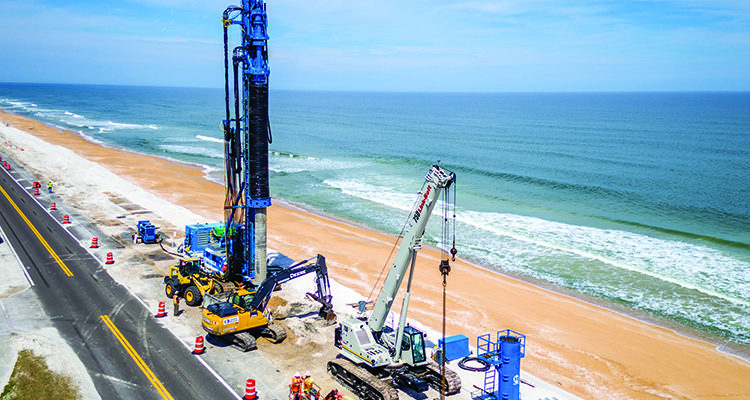This especially affected the primary pile cages, which were assembled by tying 25 straight V-Rod bars together at one end with a special pile-toe assembly, spreading the bars into a cone shape and then securing them with outside spiral hoops. Pultrall delivered enough pre-cut and preformed V-Rod for 104 cages a week for nine weeks, including 300,000 linear feet of No. 5 spiral GFRP rebar. (Rebar numbers represent a unit of 1/8-inch, so No. 5 rebar has a 5/8-inch diameter.) Fortier says that once the contractor adjusted to the process, it appreciated the convenience of receiving ready-to-assemble components.
Receiving pre-cut, pre-bent V-Rod significantly reduced on-site assembly time. At one-quarter the weight of steel rebar, using V-Rod also greatly reduced worker fatigue during cage assembly. Christian C. Steputat, P.E., a Ph.D. candidate at the University of Miami who monitored the installation of the GFRP rebar, estimates that the use of GFRP bar cages for the Flagler Beach seawall reduced installation time by up to 52%.
Although the lighter GFRP cages offered distinct advantages, they did present one challenge. “Typically with a steel cage, you’re able to drop it into the concrete, and it will pretty much go all the way down with its own weight,” explains Denty. “Whereas these [GFRP] cages are so light, they have to be physically pushed down.” However, FDOT specifications for auger-cast piles forbid mechanical pushing, so a variance from the FDOT was needed. “That specification wasn’t necessarily written for GFRP,” notes Denty.
The contractor on the project wasn’t the only company with little to no experience with composites. For Denty, the engineer of record, this was only his second infrastructure project with GFRP rebar. Initially, his firm designed the Flagler Beach seawall with steel-reinforced secant piles, but the FDOT was concerned about long-term maintenance and asked the firm to consider GFRP. “That was unexpected,” admits Denty.
Shifting from steel to GFRP rebar required a few design changes. Because the largest FDOT-approved GFRP bar at the time was a smaller No. 8 bar, the number of bars in each cage was increased. “We originally designed this for traditional steel, so we had nine No. 11 bars in a cage,” says Denty. “When we switched to GFRP, we ended up going with 25 No. 8s.”
Grout requirements also changed. The cement grout no longer needed silica fume, which was originally specified to create the denser grout needed to protect the steel rebar from corrosion. The non-corrosive GFRP rebar also allowed for a reduction of grout cover around each cage from four inches to three.
As a newer material, GFRP rebar does present some growing pains. For one thing, it’s difficult to find engineering software that allows for design with the material. For this project, Denty says that his team had to develop their own spreadsheets based on the code formulas. In addition, because GFRP bars are lighter and more flexible, contractors must be careful to ensure the cages are assembled straight, tied very securely together and supported or lifted at more locations than conventional practice, according to the FDOT.
Meanwhile, the use of GFRP rebar on bridges, seawalls and other infrastructure projects continues to grow. Coastal areas like Florida, where infrastructure battles against chloride-heavy, extreme marine environments, are leading the charge. Given the age and amount of existing coastal infrastructure, the population growth rate and future sea level encroachment, there appears to be ample opportunity for FRP reinforcement to find a sustainable market in Florida and other similarly positioned states.



